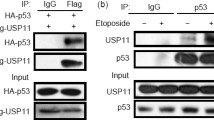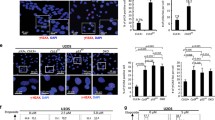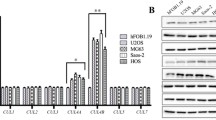Abstract
Controlled protein ubiquitination through E3 ubiquitin ligases and degradation via 26S proteasome machinery is required for orderly progression through cell cycle, chromatin remodeling, DNA repair, and development. Each cullin-dependent ubiquitin ligase (E3) complex can recruit various substrates for their degradation. Cullin 4A (CUL4A) and Cullin 4B (CUL4B) are members of cullin family proteins that mediate ubiquitin dependent proteolysis. Though, these two cul4 genes are functionally redundant, Cullin 4B is not a substitute for all the Cullin 4A functions. Published report has shown that CUL4A interacts with p53 and induces its decay. Although, CUL4A has been known to control several cellular processes, little is known about CUL4B functions. Therefore, in this study, we analyzed the role of CUL4B on p53 polyubiquitination. Our stable cell line and transient transfection studies show that CUL4B indeed interacts with p53 and induces its polyubiquitination. Importantly, both CUL4A and CUL4B overexpressing cells show almost equal levels of p53 polyubiquitination. Moreover, we observed an increased level of polyubiquitination on p53 in CUL4B overexpressing stable cell line upon treatment with siRNA specific for CUL4A indicating that CUL4B plays a vital role in p53 stability. In addition, we have observed the differential expression of CUL4B in various eukaryotic cell lines and mouse tissues suggesting the important role of CUL4B in various tissues. Together, these observations establish an important negative regulatory role of CUL4B on p53 stability.




Similar content being viewed by others
References
Hershko A, Ciechanover A (1998) The ubiquitin system. Annu Rev Biochem 67:425–479
Bosu DR, Kipreos ET (2008) Cullin-RING ubiquitin ligases: global regulation and activation cycles. Cell Div 3:7
Jiang YH, Beaudet AL (2004) Human disorders of ubiquitination and proteasomal degradation. Curr Opin Pediatr 16:419–426
Petroski MD, Deshaies RJ (2005) Function and regulation of cullin-RING ubiquitin ligases. Nat Rev Mol Cell Biol 6:9–20
Jin J, Arias EE, Chen J, Harper JW, Walter JC (2006) A family of diverse Cul4-Ddb1-interacting proteins includes Cdt2, which is required for S phase destruction of the replication factor Cdt1. Mol Cell 23:709–721
Sarikas A, Hartmann T, Pan ZQ (2011) The cullin protein family. Genome Biol 12:220
Zou Y, Mi J, Cui J, Lu D, Zhang X et al (2009) Characterization of nuclear localization signal in the N terminus of CUL4B and its essential role in cyclin E degradation and cell cycle progression. J Biol Chem 284:33320–33332
Higa LA, Zhang H (2007) Stealing the spotlight: CUL4-DDB1 ubiquitin ligase docks WD40-repeat proteins to destroy. Cell Div 2:5
Angers S, Li T, Yi X, MacCoss MJ, Moon RT, Zheng N (2006) Molecular architecture and assembly of the DDB1-CUL4A ubiquitin ligase machinery. Nature 443:590–593
Higa LA, Wu M, Ye T, Kobayashi R, Sun H, Zhang H (2006) CUL4-DDB1 ubiquitin ligase interacts with multiple WD40-repeat proteins and regulates histone methylation. Nat Cell Biol 8:1277–1283
He YJ, McCall CM, Hu J, Zeng Y, Xiong Y (2006) DDB1 functions as a linker to recruit receptor WD40 proteins to CUL4-ROC1 ubiquitin ligases. Genes Dev 20:2949–2954
Higa LA, Wu M, Ye T, Kobayashi R, Sun H, Zhang H (2006) CUL4-DDB1 ubiquitin ligase interacts with multiple WD40-repeat proteins and regulates histone methylation. Nat Cell Biol 8:1277–1283
Leung-Pineda V, Huh J, Piwnica-Worms H (2009) DDB1 targets Chk1 to the Cul4 E3 ligase complex in normal cycling cells and in cells experiencing replication stress. Cancer Res 69:2630–2637
Banks D, Wu M, Higa LA, Gavrilova N, Quan J et al (2006) L2DTL/CDT2 and PCNA interact with p53 and regulate p53 polyubiquitination and protein stability through MDM2 and CUL4A/DDB1 complexes. Cell Cycle 5:1719–1729
Kim Y, Starostina NG, Kipreos ET (2008) The CRL4Cdt2 ubiquitin ligase targets the degradation of p21Cip1 to control replication licensing. Genes Dev 22:2507–2519
Abbas T, Sivaprasad U, Terai K, Amador V, Pagano M, Dutta A (2008) PCNA-dependent regulation of p21 ubiquitylation and degradation via the CRL4Cdt2 ubiquitin ligase complex. Genes Dev 22:2496–2506
Li B, Jia N, Waning DL, Yang FC, Haneline LS, Chun KT (2007) Cul4A is required for hematopoietic cell viability and its deficiency leads to apoptosis. Blood 110:2704–2707
Chen LC, Manjeshwar S, Lu Y, Moore D, Ljung BM et al (1998) The human homologue for the Caenorhabditis elegans cul-4 gene is amplified and overexpressed in primary breast cancers. Cancer Res 58:3677–3683
Yasui K, Arii S, Zhao C, Imoto I, Ueda M et al (2002) TFDP1, CUL4A, and CDC16 identified as targets for amplification at 13q34 in hepatocellular carcinomas. Hepatology 35:1476–1484
Tarpey PS, Raymond FL, O’Meara S, Edkins S, Teague J et al (2007) Mutations in CUL4B, which encodes a ubiquitin E3 ligase subunit, cause an X-linked mental retardation syndrome associated with aggressive outbursts, seizures, relative macrocephaly, central obesity, hypogonadism, pes cavus, and tremor. Am J Hum Genet 80:345–352
Zou Y, Liu Q, Chen B, Zhang X, Guo C et al (2007) Mutation in CUL4B, which encodes a member of cullin-RING ubiquitin ligase complex, causes X-linked mental retardation. Am J Hum Genet 80:561–566
Kerzendorfer C, Whibley A, Carpenter G, Outwin E, Chiang SC et al (2010) Mutations in Cullin 4B result in a human syndrome associated with increased camptothecin-induced topoisomerase I-dependent DNA breaks. Hum Mol Genet 19:1324–1334
Higa LA, Mihaylov IS, Banks DP, Zheng J, Zhang H (2003) Mutations in Cullin 4B result in a human syndrome associated with increased camptothecin-induced topoisomerase I-dependent DNA breaks. Nat Cell Biol 5:1008–1015
Hu J, McCall CM, Ohta T, Xiong Y (2004) Targeted ubiquitination of CDT1 by the DDB1-CUL4A-ROC1 ligase in response to DNA damage. Nat Cell Biol 6:1003–1009
Santoro JG, Kapetanaki MG, Hsieh CL, Gorbachinsky I, Levine AS, Rapic′-Otrin V (2008) The Cullin 4B-based UV-damaged DNA-binding protein ligase binds to UV-damaged chromatin and ubiquitinates histone H2A. Cancer Res 68:5014–5022
Li X, Lu D, He F, Zhou H, Liu Q et al (2011) Cullin 4B protein ubiquitin ligase targets peroxiredoxin III for degradation. J Biol Chem 286:32344–32354
Wang H, Zhai L, Xu J, Joo HY, Jackson S et al (2006) Histone H3 and H4 ubiquitylation by the CUL4-DDB-ROC1 ubiquitin ligase facilitates cellular response to DNA damage. Mol Cell 22:383–394
Liu L, Lee S, Zhang J, Peters SB, Hannah J et al (2009) CUL4A abrogation augments DNA damage response and protection against skin carcinogenesis. Mol Cell 34:451–460
Kopanja D, Roy N, Stoyanova T, Hess RA, Bagchi S, Raychaudhuri P (2011) Cul4A is essential for spermatogenesis and male fertility. Dev Biol 352:278–287
Hori T, Osaka F, Chiba T, Miyamoto C, Okabayashi K et al (1999) Covalent modification of all members of human cullin family proteins by NEDD8. Oncogene 18:6829–6834
Prives C, Hall PA (1999) The p53 pathway. J Pathol 187:112–126
Lee JT, Gu W (2010) The multiple levels of regulation by p53 ubiquitination. Cell Death Differ 17:86–92
Nag A, Bagchi S, Raychaudhuri P (2004) Cul4A physically associates with MDM2 and participates in the proteolysis of p53. Cancer Res 64:8152–8155
Bondar T, Kalinina A, Khair L, Kopanja D, Nag A et al (2006) Cul4A and DDB1 associate with Skp2 to target p27Kip1 for proteolysis involving the COP9 signalosome. Mol Cell Biol 26:2531–2539
Lee J, Zhou P (2012) Pathogenic role of the CRL4 ubiquitin ligase in human disease. Front Oncol 6:2–21
Liu L, Yin Y, Li Y, Prevedel L, Lacy EH, Ma L, Zhou P (2012) Essential role of the CUL4B ubiquitin ligase in extra-embryonic tissue development during mouse embryogenesis. Cell Res 22:1258–1269
Jiang B, Zhao W, Yuan J, Qian Y, Sun W et al (2012) Lack of Cul4b, an E3 ubiquitin ligase component, leads to embryonic lethality and abnormal placental development. PLoS ONE 7:37070
Tripathi R, Sastry KS, Kota SK, Srinivas UK (2005) Cloning and characterization of mouse cullin4B/E3 ubiquitin ligase. J Biosci 30:329–337
Yamasaki S, Yagishita N, Sasaki T, Nakazawa M, Kato Y et al (2007) The multiple levels of regulation by p53 ubiquitination. EMBO 26:113–122
Li M, Brooks CL, Wu-Baer F, Chen D, Baer R, Gu W (2003) Mono- versus polyubiquitination: differential control of p53 fate by Mdm2. Science 302:1972–1975
Kapetanaki MG, Guerrero-Santoro J, Bisi DC, Hsieh CL, Rapic-Otrin V, Levine AS (2006) The DDB1-CUL4ADDB2 ubiquitin ligase is deficient in xeroderma pigmentosum group E and targets histone H2A at UV-damaged DNA sites. Proc Natl Acad Sci USA 103:2588–2593
Nakagawa T, Xiong Y (2011) X-linked mental retardation gene CUL4B targets ubiquitylation of H3K4 methyltransferase component WDR5 and regulates neuronal gene expression. Mol Cell 43:381–391
Lee J, Zhou P (2010) Cullins and cancer. Genes Cancer 1:690–699
Jackson S, Xiong Y (2009) CRL4s: the CUL4-RING E3 ubiquitin ligases. Trends Biochem Sci 34:562–570
Acknowledgments
We are very grateful to Prof. Pradip Raychaudhuri for providing necessary plasmids used in this study. We express sincere thanks to Dr. Srilata Bagchi for technical advice and constant support. I especially thank Dr. Arunkumar Dhayalan for critical reading of the manuscript. This work is supported by Department of Science and Technology-SERB, INDIA grants; SB/EMEQ: 038/2013 and SR/FT/LS 76/2011 to SB.
Author information
Authors and Affiliations
Corresponding author
Rights and permissions
About this article
Cite this article
Thirunavukarasou, A., Singh, P., Govindarajalu, G. et al. E3 ubiquitin ligase Cullin4B mediated polyubiquitination of p53 for its degradation. Mol Cell Biochem 390, 93–100 (2014). https://doi.org/10.1007/s11010-014-1960-3
Received:
Accepted:
Published:
Issue Date:
DOI: https://doi.org/10.1007/s11010-014-1960-3




